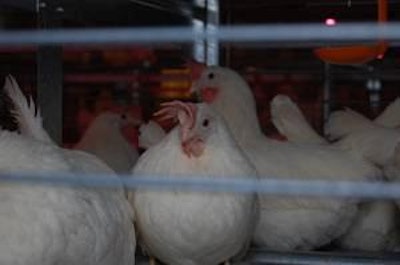
Passage of H.R. 3798, the hen welfare agreement legislation, continued to be a hot topic of conversation at the United Egg Producers annual meeting held recently in San Diego. United Egg Producers staff, consultants and many board members and egg producer members pledged support for efforts to pass H.R. 3798 at the meeting, but support among egg producers is not universal.
Amon Baer is an egg producer from Lake Park, Minn., who is a principal in both Mendelson Egg Company and Baer Brothers Inc. The four Baer brothers each have their own egg farms, and these family run farms have a total of 1.4 million hens. Amon Baer is a board member, but has also been a de facto spokesperson for egg producers who are not supportive of passage of H.R. 3798. In July of this year, he testified before the Senate agriculture committee and presented reasons why he and some other small to mid-sized egg producers are against passage of H.R. 3798.
Three months later, Baer is still presenting the opposition view regarding H.R. 3798. His first objection to H.R. 3798 stems from his belief in limited government intervention in the private sector and his faith in free markets. He said that the ballot initiatives that have passed in California, Michigan and Ohio and that were pending in Washington and Oregon, prior to the signing of the United Egg Producers and the Humane Society of the United States agreement, would not impact all U.S. egg producers, so federal legislation was not required to address the hen housing issue. The marketplace would determine how much consumers are willing to pay for eggs and how these eggs would need to be produced; consumer choice would sort this all out.
Cage densities
Baer used the introduction of the UEP Certified program as an example of the impact of free markets and a voluntary animal welfare program. When the UEP Certified program was initiated, participating egg producers voluntarily increased the amount of cage space provided per hen from approximately 50 square inches per hen to 67 square inches. Baer said that he asked his customers whether or not this was something that they were interested in him participating in, and if they be willing to pay more for these eggs. His customers responded that they were interested in a steady supply of safe, affordable eggs for their customers and that cage density was not a concern. Based on this feedback, Baer chose not to participate in the UEP Certified program.
Baer’s hens are still housed at cage densities that would not meet the UEP Certified standard. He questioned how anyone could keep birds warm during winter months in northern Minnesota at the cage densities called for in H.R. 3798 while still keeping in-house ammonia levels below 25 parts per million in deep pit houses.
Operating costs
A second major objection that Baer has with H.R. 3798 is that the impact on individual producers will vary depending on the age and condition of the producer’s cages (see Table 1). To illustrate his concern, consider a hypothetical example of two neighbors who have egg farms: one who replaced his cages in 2010, and the other who needs to replace cages shortly. In this extreme example, the producer with the cages dating to 2010 would not be required to give hens more space or enrichments until 18 years after the agreement is signed, but the neighbor who needs new cages now would have to invest in enrichable cages and begin giving birds more space than his neighbor within three years of the agreement being signed. So the neighbor who invests in the new cages would have higher operating costs, particularly in years three through 18.
A large egg producer with multiple locations will likely have a range of ages of equipment and will convert houses over a number of years, and this will spread out the cost and “average” out the cost of production, but small producers might not be so lucky. A small producer may have old cages that need to be replaced soon, this may be the only house or houses that they have. They will be operating at a cost disadvantage until the rest of the industry converts.
Baer asked, “How does that producer survive with higher cost for 10 or more years?” He followed this up by asking, “What financial institution would lend the producer money to buy new enrichable cages to operate given this cost disadvantage?” Could H.R. 3798 have a “lottery” like impact for small producers depending on whether their cages just happen to be old or new right now?
Timing
At the United Egg Producers annual meeting, some members asked if certain aspects of the hen welfare agreement with the Humane Society of the United States might be renegotiated, particularly if the H.R. 3798 doesn’t pass. The issue was not side stepped, but based on positions stated by members of the board of the United Egg Producers, the cooperative remains fully committed to getting H.R. 3798 passed in its current form.
Success or failure in business frequently is impacted by timing and luck. Some egg producers think that H.R. 3798 makes timing of when cages were installed the determining factor in whether their egg farm will stay in business or not, and they are not happy about legislation determining their fate.


















